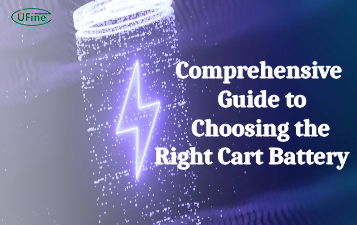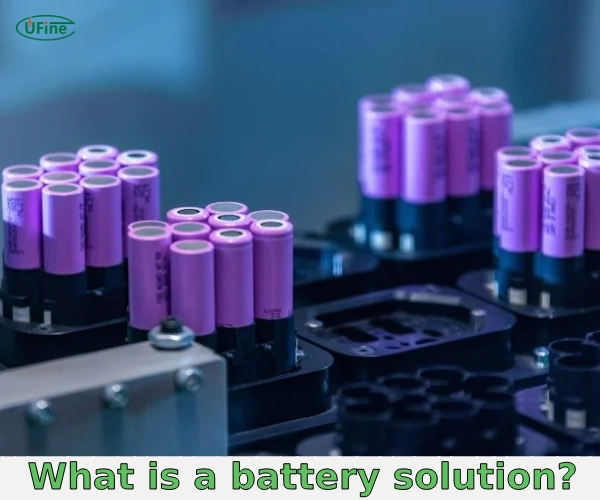What is a battery solution? Have you ever wondered how your gadgets stay powered up? In this article, we’ll explore what a battery solution is and break down its key components. We’ll also look at different battery solutions and how they work. Let’s dive in and learn all about the technology that keeps our electronic devices running!
Part 1. What is a battery solution?
A battery solution is a complete system that powers electronic devices. It has many parts working together. The main parts are the battery, the charger, and the management system. The battery stores the power. The charger fills the battery with power. The management system makes sure everything works safely and efficiently. This solution includes any extra tools or infrastructure needed to support these parts.
Components of a Battery Solution
A battery solution comprises several essential components, each playing a crucial role in the overall functionality. Here is a detailed look at each part:
- Battery Cell: This core component stores and releases electrical energy. Battery cells come in various types, such as cylindrical, prismatic, and pouch cells, each with unique characteristics and applications.
- Electrolyte: The electrolyte is a chemical medium that allows the flow of electrical charge between the cathode and anode. It can be liquid, gel, or solid. The choice of electrolyte affects the battery’s performance, safety, and longevity.
- Cathode and Anode: These are the two electrodes where the chemical reactions occur. The cathode is the positive electrode, and the anode is the negative electrode. Different materials used for these electrodes (like lithium, nickel, or graphite) influence the battery’s energy density and cycle life.
- Separator: The separator is a thin membrane between the cathode and anode. It prevents physical contact between the electrodes while allowing ionic flow, ensuring safety and efficiency.
- Battery Management System (BMS): The BMS monitors and controls the battery’s operation. It ensures optimal performance by managing the charging and discharging processes, balancing the cells, and protecting against overcharging, overheating, and short circuits.
- Charging Mechanism: This includes the charger and any associated electronics. The charging mechanism safely and efficiently replenishes the battery’s energy. It can feature different technologies like fast, wireless, and intelligent charging protocols.
- Thermal Management System: Batteries can generate heat during operation, especially during high discharge or fast charging. A thermal management system helps maintain the battery at an optimal temperature range to prevent overheating and ensure safety and longevity.
- Casing and Housing: The casing protects the internal components from physical and environmental damage. It typically uses durable materials like metal or plastic, making it lightweight yet robust.
- Connectors and Wiring: These components link the battery to its power device. High-quality connectors and wiring are crucial for efficient power transfer and minimizing energy loss.
Part 2. Types of battery solutions
Primary vs. Secondary Batteries
Primary batteries are non-rechargeable. You use them once, and then you throw them away. They are simple and easy to use. Typical examples are AA or AAA batteries in toys and remote controls.
Secondary batteries are rechargeable. You can use them over and over again. They save money and reduce waste. Examples include batteries in phones, laptops, and electric cars.
Common Battery Chemistries
Different batteries use different materials. This affects their functionality and the purposes for which they are most suitable. Here are some common types:
- Lithium-Ion: These batteries are light and have a high energy capacity. Phones, laptops, and electric cars utilize them. They charge quickly and last a long time. However, they can be expensive and need careful handling to avoid overheating.
- Lead-Acid: These are older types of batteries. They are lighter and less potent than lithium-ion batteries. Cars and backup power systems utilize them. They are cheaper but last less time and need regular maintenance.
- Nickel-Metal Hydride (NiMH): These batteries are safe and stable. Cameras, power tools, and some electric vehicles utilize them. They balance cost and performance well but may lose charge over time if not actively used.
Lithium-Ion: Advantages, Applications, and Limitations
- Advantages: High energy density, lightweight, and fast charging.
- Applications: Smartphones, laptops, electric cars, and portable power tools.
- Limitations: They can overheat if not appropriately managed, are more expensive, and degrade over time.
Lead-Acid: Uses, Benefits, and Drawbacks
- Uses: Cars, trucks, and backup power systems.
- Benefits: Low cost and reliable performance.
- Drawbacks: Heavy, shorter lifespan, and require maintenance.
Nickel-Metal Hydride: Key Features and Common Uses
- Key Features: Good energy capacity, safe to use, and relatively affordable.
- Common Uses: Digital cameras, power tools, hybrid vehicles, and medical devices.
Part 3. Applications of battery solutions
Applications of Battery Solutions
Battery solutions have many applications in our daily lives and various industries. Here are some common uses:
Consumer Electronics
Battery solutions power our smartphones, tablets, laptops, and wearable devices. They provide the energy needed to stay connected, work, and entertain ourselves on the go.
Transportation
Electric vehicles (EVs) rely on battery solutions to drive without emitting harmful pollutants. Batteries enable clean and sustainable transportation options, from electric cars to e-bikes and scooters.
Renewable Energy Storage
Battery solutions are crucial in storing energy generated from renewable sources like solar and wind. They help balance supply and demand, ensuring a stable and reliable power grid.
Backup Power
Battery solutions provide backup power during outages or emergencies. They keep essential systems running in homes, businesses, hospitals, and critical infrastructure like telecommunications and data centers.
Aerospace and Aviation
Aircraft use batteries for emergency power and auxiliary functions. They also power drones and satellites, enabling remote sensing, communication, and exploration.
Military and Defense
Battery solutions are essential for powering military equipment, including communication devices, portable electronics, and uncrewed vehicles. They provide reliable energy in challenging environments and missions.
Medical Devices
Various medical devices utilize battery solutions, from pacemakers and insulin pumps to portable diagnostic equipment. They enable mobility and independence for patients while ensuring continuous operation.
Marine and Offshore
Batteries power electric propulsion systems for ships and submarines, reducing emissions and improving efficiency. They also support offshore operations, such as oil and gas exploration, where reliable power is essential.
Remote and Off-Grid Applications
Battery solutions power remote locations where access to the grid is limited or nonexistent. They provide power for off-grid homes, remote communication towers, and scientific research stations in remote areas like Antarctica.
Industrial and Commercial
Various industrial and commercial applications integrate battery solutions, including forklifts, electric tools, backup power for telecommunications, and energy storage systems for large-scale facilities.
Part 4. What is the difference between primary and secondary battery solutions?
1. Rechargeability:
- Primary Batteries: Non-rechargeable; cannot be recharged after depletion.
- Secondary Batteries: Rechargeable; can be recharged multiple times for extended use.
2. Lifespan:
- Primary Batteries: They have a single-use lifespan and require replacement once depleted.
- Secondary Batteries: They have a longer lifespan, and users can recharge and reuse them multiple times.
3. Chemistry:
- Primary Batteries: Typically use irreversible chemical reactions, making them unsuitable for recharging.
- Secondary Batteries: Utilize reversible chemical reactions, allowing for recharging via an external electrical current.
4. Cost:
- Primary Batteries: Generally cheaper upfront due to single-use nature.
- Secondary Batteries: While the initial costs may be higher, users can benefit from long-term savings by reusing them.
5. Environmental Impact:
- Primary Batteries: Contribute to more waste when users dispose of them after a single use.
- Secondary Batteries: Reduce environmental impact by reducing the need for disposable batteries.
6. Convenience:
- Primary Batteries: Convenient for devices with low power demands or infrequent usage; replace when depleted.
- Secondary Batteries: Ideal for high-power devices or applications requiring frequent use; can be recharged when needed.
7. Energy Density:
- Primary Batteries: Generally have higher initial energy density.
- Secondary Batteries may have slightly lower initial energy density but compensate for rechargeability.
8. Application Range:
- Primary Batteries: Suited for low-power, disposable applications such as remote controls, toys, and disposable medical devices.
- Secondary Batteries: Widely used in high-power applications such as smartphones, laptops, electric vehicles, and renewable energy storage systems.
Part 5. Choosing the right battery solution
1. Energy Requirements:
Assess Power Needs: Determine the energy demands of the device or system to be powered. Consider factors such as voltage, current, and duration of operation to choose a battery with sufficient capacity.
2. Size and Weight Constraints:
Evaluate Size and Weight: Consider the device’s or equipment’s physical dimensions and limitations. Choose a battery solution that fits within the available space and meets weight restrictions without compromising performance.
3. Environmental Conditions:
Consider Environmental Factors: Evaluate the operating environment, including temperature extremes, humidity levels, and exposure to vibration or shock. Select a battery solution with a suitable temperature range and ruggedness to withstand environmental challenges.
4. Cost-effectiveness:
Analyze Cost vs. Performance: Compare different battery options’ initial cost, lifespan, and maintenance requirements. Consider the long-term value and total cost of ownership to determine the most cost-effective solution.
5. Rechargeability:
Determine Rechargeability Needs: Assess whether rechargeable or non-rechargeable batteries are more suitable for the application. Consider factors such as frequency of use, downtime between charges, and the availability of charging infrastructure.
6. Safety and Reliability:
Prioritize Safety: Choose battery solutions from reputable manufacturers with a proven safety and reliability track record. Look for certifications and compliance with industry standards to ensure quality and minimize the risk of accidents or malfunctions.
7. Compatibility and Interoperability:
Ensure Compatibility: Verify compatibility between the battery solution and the device or system it powers. Consider factors such as voltage compatibility, connector types, and communication protocols to ensure seamless integration and interoperability.
8. Environmental Impact:
Consider Sustainability: Evaluate the environmental impact of different battery chemistries and disposal options. Choose eco-friendly options such as rechargeable batteries or those with recyclable materials to minimize your ecological footprint.
Part 6. Advances in battery solutions
1. Increased Energy Density:
Lithium-Sulfur Batteries: Emerging battery chemistry with higher energy density than traditional lithium-ion batteries, offering longer runtime and lighter weight for portable electronics and electric vehicles.
2. Fast Charging Capabilities:
Solid-State Batteries: Solid-state electrolytes enable faster charging and increased safety compared to liquid electrolytes, paving the way for rapid charging in electric vehicles and consumer electronics.
3. Extended Lifespan:
Flow Batteries: Flow battery technology utilizes liquid electrolytes stored in external tanks, enabling long cycle life and scalability for grid-scale energy storage applications such as renewable energy integration and peak shaving.
4. Sustainable Materials:
Graphene-Based Batteries: Batteries incorporating graphene, a carbon-based material, offer improved conductivity, durability, and environmental sustainability compared to traditional battery materials, contributing to reduced environmental impact and resource conservation.
5. Enhanced Safety Features:
Smart Battery Management Systems (BMS): Advanced BMS technologies incorporate real-time monitoring, thermal management, and predictive analytics to optimize battery performance, prevent overcharging, and mitigate safety risks in electric vehicles and energy storage systems.
6. Integration with Renewable Energy:
Hybrid Energy Systems: Integrating battery storage with renewable energy sources such as solar and wind enables grid stabilization, load shifting, and increased renewable energy penetration, fostering a more sustainable and resilient energy infrastructure.
7. Wireless Charging:
Inductive and Resonant Charging: Wireless charging technologies eliminate the need for physical connectors, enabling convenient and efficient charging of devices in various applications, from smartphones and wearables to electric vehicles and industrial equipment.
8. AI-Driven Optimization:
AI-Powered Battery Management: Artificial intelligence algorithms analyze battery performance data in real-time, optimizing charging and discharging cycles, extending battery lifespan, and improving energy efficiency in smart grid and IoT applications.
Part 7. FAQs
-
What is the difference between battery solution and distilled water?
Battery solution is a chemical mixture used in batteries to generate electricity. At the same time, distilled water is purified without impurities and is used mainly for hydration and industrial purposes. -
How do battery solutions impact renewable energy storage?
Battery solutions enable the storage of excess energy from renewable sources, helping balance supply and demand for a stable power grid. -
What are the latest innovations in battery technology?
Recent innovations in battery technology include lithium-sulfur batteries, solid-state batteries, and flow batteries for various applications. -
What is the most common type of battery solution used today?
Lithium-ion batteries are the most common solution today, powering smartphones, laptops, electric vehicles, and renewable energy storage systems. -
How can I extend the lifespan of my battery solution?
To extend the lifespan of your battery solution, avoid overcharging, maintain optimal operating conditions, and regularly inspect and clean battery terminals.
Related Tags:
More Articles

Comprehensive Guide to Choosing the Right Cart Battery
Choosing the right cart battery ensures optimal performance and longevity. This guide covers cart battery types and helps you make an informed choice.
The Ultimate Guide to 18650 Button Top Battery
18650 button top batteries are popular for their high energy density and reliability. This guide covers their key features, usage, and maintenance tips.
The Power of Slim: Unveiling the Potential of Flat Lithium Ion Battery
Flat lithium-ion batteries power devices from phones to vehicles. This article explores their design, benefits, types, applications, charging, and safety.
The Comprehensive Guide to Battery Balancing and Battery Balancer
Battery balancing and balancers optimize performance, longevity, and safety. This guide covers techniques and tips for choosing the right balancer.
10 Key Facts About Drone Battery for 2024
Uncover crucial insights with "10 Key Facts About Drone Battery for 2024." Learn the latest trends and essential details on drone batteries.




